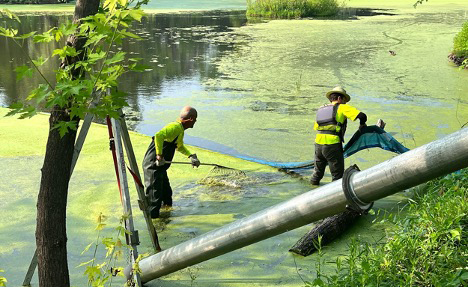by John Bilotta
Stormwater runoff from our communities - from streets, driveways, parking lots, and rooftops - often negatively impacts lakes, rivers, streams, wetlands and sometimes, shallow groundwater resources. Urban stormwater runoff carries with it pollutants such as nutrients, pathogens, and sediment that can lead to degraded water quality in the receiving water body. The increased volume and rate at which runoff happens can lead to localized and downstream flooding. In light of these impacts, practitioners, professionals, policymakers and property owners must adopt innovative practices, policies, and management approaches that prevent and minimize water quality degradation and at the same time decrease the quantity or amount of runoff.

Research can identify new methods for urban stormwater management, discover new practices and innovations, and inform policy changes. The Minnesota Stormwater Research and Technology Transfer Program is advancing science, technology, and management of stormwater in Minnesota by investing in and facilitating research to prevent, minimize, and mitigate the impacts of runoff from the built environment. The program operates in tandem with the Minnesota Stormwater Research Council ensuring diverse and comprehensive input on information needs and priorities. The Minnesota Sea Grant Program is a collaborator in these efforts.
Five new research projects underway during the summer of 2023
Designed and constructed urban stormwater ponds are one of the most used practices to manage stormwater and there are tens of thousands of these ponds across the state. While they have been a go-to practice for decades, there are uncertainties about their performance to meet current water quality needs and much is unknown about how they function.
In response to these uncertainties and information (research) needs, this past June marked the beginning of four new research projects investigating urban stormwater ponds. The new, innovative projects include research investigations on
- The fate and transport of phosphorus and harmful algae blooms (HABs) from stormwater ponds
- The effectiveness of pond remediation techniques on phosphorus release rates
- The enhancement and validation of a rapid stormwater pond assessment tool
- How managing urban pond vegetation can be accomplished to enhance water quality benefits
The fifth research project focuses on another poorly understood component of urban stormwater, specifically, how homeowner associations (HOAs) manage stormwater. HOAs group owners of properties in a unique neighborhood or area into a legal association or network. Many people may relate HOAs to neighborhood social gatherings, common roof and building exterior management, seasonal yard care of common areas and snow removal. In addition, as it turns out, many HOAs own and operate stormwater practices within their boundaries yet little is known about how HOAs maintain them. In response to this information gap, the program invested in a fifth research project this summer.
- Assessing the capacity of and identifying effective resources for homeowners, associations (HOAs) and commercial property owners for proper maintenance of stormwater and green infrastructure practices These new projects coupled with ongoing projects reflect the Minnesota Stormwater Research Council’s investment into twelve unique areas of study. More about each of these twelve projects can be found online at wrc.umn.edu/stormwater-projects
Technology transfer - delivering research results to practitioners, professionals and policymakers
Another emphasis of the Minnesota Stormwater Research and Technology Transfer program is to transfer the discoveries of these research projects to the practitioners, professionals and policymakers that are in the best position to use research results to design, install, maintain, and operate practices across public and private development and redevelopment projects. Here are a few examples of Extension education programming that aims to transfer this information:
- The Minnesota Stormwater Seminar Series brings exemplars of advanced stormwater innovation and knowledge to Minnesota to share what they’ve learned and how they’ve pushed the boundaries in the stormwater arena. Seminars also include presentations of Minnesota Stormwater Research Council funded projects and interdisciplinary panels
- The Clean Sweep Education and Training Program was launched in 2022 as the result of discoveries made through multiple research projects. The program was developed in partnership with the Minnesota Pollution Control Agency to assist municipal separate storm sewer systems (MS4s) and local communities in implementing and enhancing their own street sweeping programs to help meet water quality goals
- Research results are continually incorporated into training programs such as the Inspection and Maintenance of Permanent Stormwater Treatment Practices Certification provided by the Erosion and Stormwater Management Certification Program.